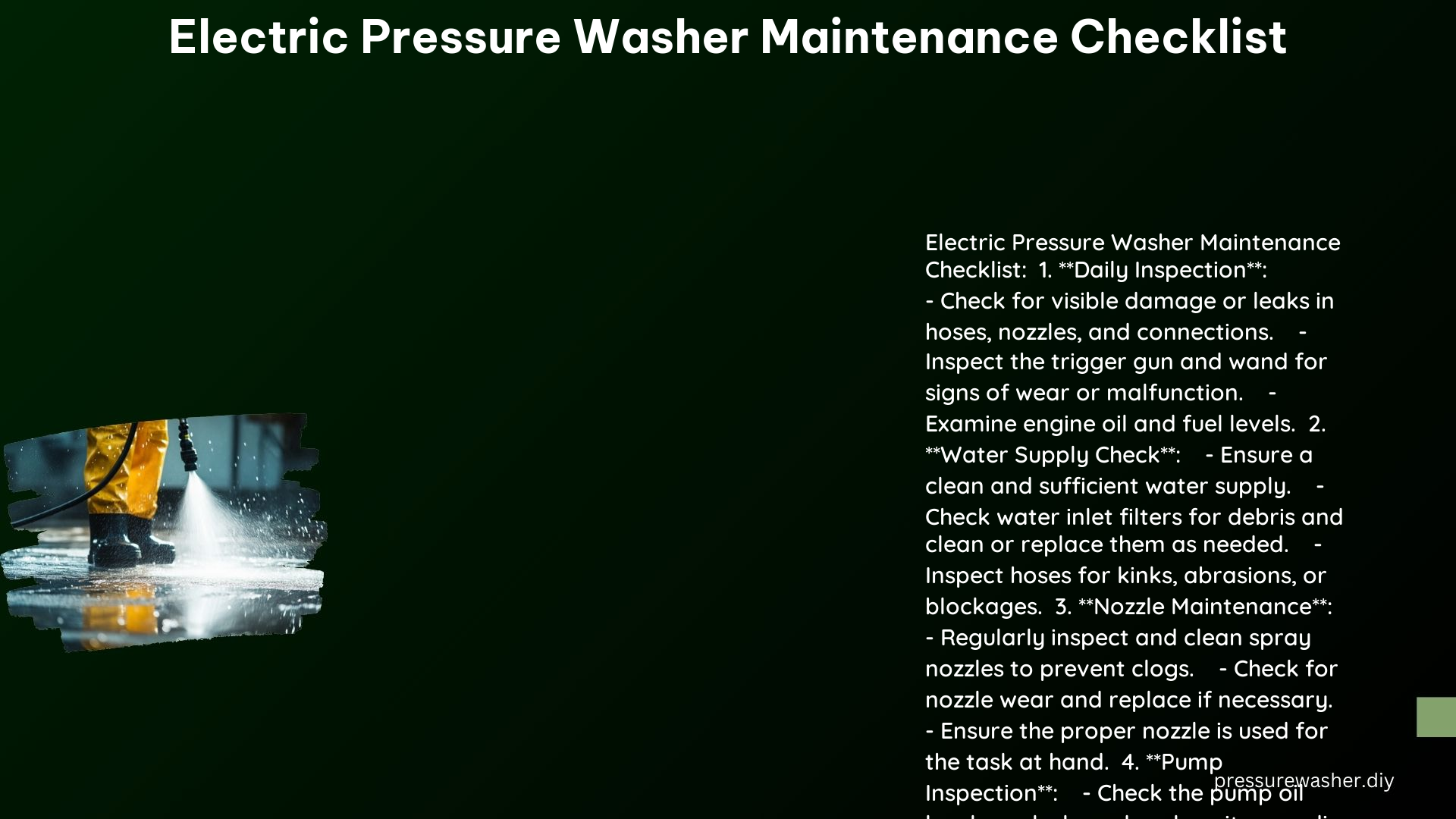An electric pressure washer is a powerful cleaning tool that can make quick work of various outdoor cleaning tasks, from washing cars to cleaning patios and decks. However, to ensure its longevity and optimal performance, regular maintenance is crucial. This comprehensive guide will walk you through a detailed electric pressure washer maintenance checklist, covering daily, weekly, monthly, and long-term storage requirements, as well as technical specifications and tips to prevent mineral buildup.
Daily Maintenance
Check the Oil Pump
Ensure the oil pump is at the recommended level, which is typically between the “MIN” and “MAX” markings on the dipstick. Refer to the manufacturer’s manual for the correct oil type and level.
Inspect Hoses
Carefully examine both the supply hose and the high-pressure hose for any signs of damage, such as abrasion, bulges, cuts, leaks, or kinks. Replace any damaged hoses immediately to prevent further issues.
Verify Operating Pressure and Temperature
Ensure the pressure washer is operating within the recommended pressure and temperature ranges, as specified in the user manual. Exceeding these limits can lead to premature wear and potential damage to the machine.
Inspect the Pump
Check the pump for any water leaks and ensure it is functioning properly. Listen for any unusual noises or vibrations, which could indicate a problem.
Inspect the Drop Cord
Visually inspect the drop cord for any signs of damage, such as cracks, fraying, or exposed wires. Replace the cord if any issues are found to prevent electrical hazards.
Post-Use Maintenance

Clean the Machine
After each use, run clean water through the injector to remove any remaining detergent or chemicals. This will help prevent mineral buildup and corrosion within the system.
Store the High-Pressure Hose
Carefully wind the high-pressure hose and store it neatly on the designated hooks or storage compartment. Avoid kinking or twisting the hose, as this can lead to premature wear and damage.
Store the Extension Cord
Coil the extension cord into a circular shape and hang it on a wall-mounted hook or store it in a dry location. This will help maintain the cord’s integrity and make it easy to access for the next use.
Weekly Maintenance
Check the Fuel and Engine Oil Levels (Gas Pressure Washers)
For gas-powered pressure washers, ensure the fuel and engine oil levels are at the recommended levels specified by the manufacturer. Refill as necessary to ensure proper operation.
Flush the Water System (Gas Pressure Washers)
Before installing the pressure tip, flush the water system on gas-powered pressure washers to remove any built-up material or debris that could clog the nozzle.
Monthly Maintenance
Check the Driver Belt
Inspect the driver belt for any signs of wear, such as cracks, fraying, or excessive looseness. Ensure the belt is properly tensioned according to the manufacturer’s specifications.
Check Hoses and Fittings
Thoroughly inspect all hoses and fittings for leaks, cracks, or other damage. Replace any worn or damaged components to prevent further issues.
Check the Pump Oil Level
Ensure the pump oil level is at the recommended level, as specified in the user manual. Top up the oil if necessary.
Check the Pressure and Temperature Levels
Verify that the pressure washer is operating within the recommended pressure and temperature ranges. Refer to the manufacturer’s guidelines for the appropriate values.
Check the Burner Operation (Gas Pressure Washers)
For gas-powered pressure washers with a heating coil, ensure the burner is functioning correctly. Look for proper ignition, flame pattern, and overall operation.
Inspect the Coil for Lime Deposits and Soot (Gas Pressure Washers)
Examine the heating coil on gas-powered pressure washers for any buildup of lime deposits or soot, which can impair the coil’s efficiency and performance.
Check the Fuel Filter (Gas Pressure Washers)
Inspect the fuel filter on gas-powered pressure washers for any dirt or soil deposits, and replace it if necessary to maintain proper fuel flow.
Check Nozzles for Damage
Inspect the pressure washer’s nozzles for any signs of wear, clogging, or damage. Replace damaged nozzles to ensure optimal cleaning performance.
Check the Pump’s Proper Operation
Ensure the pump is functioning correctly by observing its operation and listening for any unusual noises or vibrations.
Check Couplers for O-ring Wear and Damage
Inspect the couplers, which connect the hoses to the pressure washer, for any wear or damage to the O-rings. Replace the O-rings if necessary to prevent leaks.
Long-Term Storage
Drain the Fuel (Gas Pressure Washers)
For gas-powered pressure washers, drain the fuel from the tank before storing the machine. This will prevent the fuel from deteriorating and causing issues with the engine and fuel system.
Use a Fuel Stabilizer (Gas Pressure Washers)
If you need to store the pressure washer with fuel in the tank, use a fuel stabilizer to prevent the fuel from breaking down and causing problems.
Store the Pressure Washer in a Dry Location
Ensure the pressure washer is stored in a dry, well-ventilated area to prevent water damage and corrosion.
Use a Pump Protector (Gas Pressure Washers)
For gas-powered pressure washers, use a pump protector solution to prevent damage from freezing temperatures during storage.
Technical Specifications
Electric Motor Washers
Electric pressure washers generally require less maintenance than their gasoline-powered counterparts, as they have fewer moving parts and do not require fuel or oil changes.
Hot Pressure Washers
Hot water pressure washers have additional components, such as a float tank and heating coil, which require extra maintenance to ensure proper operation and prevent issues.
Preventing Mineral Buildup
Use an Inline Filter
Install an inline filter on the water supply line to help prevent mineral buildup within the pressure washer’s internal components.
Run Clean Water Through the Injector
After each use, run clean water through the detergent injector to flush out any remaining chemicals or minerals, which can lead to clogging and corrosion over time.
Additional Tips
- Read the Manual: Thoroughly read the pressure washer’s user manual to understand the specific maintenance requirements and recommendations for your model.
- Use Approved Detergents: Only use detergents and cleaning solutions that are recommended by the manufacturer to prevent damage to the pressure washer’s components.
- Perform Regular Inspections: Regularly inspect the pressure washer to identify and address any issues before they become major problems, ensuring optimal performance and longevity.
By following this comprehensive electric pressure washer maintenance checklist, you can keep your machine in top condition, extend its lifespan, and ensure it continues to deliver reliable and efficient cleaning performance for years to come.
References:
– Preventative Maintenance for Pressure Washers
– Electric Pressure Washer Maintenance
– Pressure Washer Maintenance
– Industrial Pressure Washer Maintenance Checklist
– Pressure Washer Maintenance Checklist
